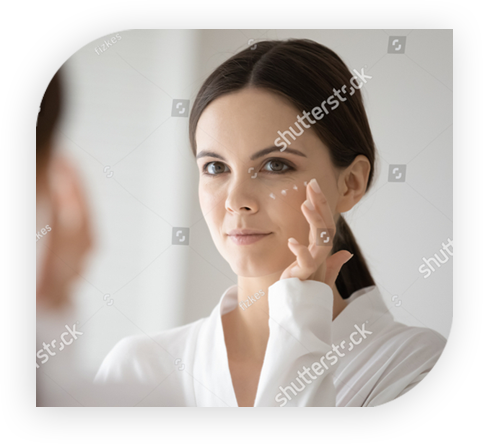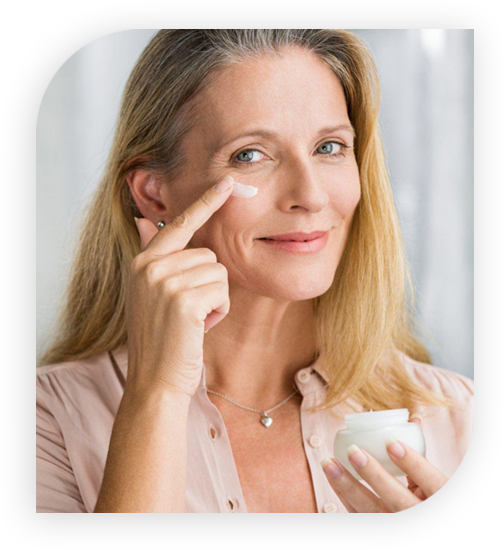Share This Article

Eye Cream Importance

Some advisors suggest that eye creams are a waste of money and you should use your regular moisturizer around your eyes. You can do that, but you can also run a marathon in your street shoes.
Using a moisturizer around your eyes may cause harm over time, because the skin around your eyes is only 1/9th the thickness of skin anywhere else on your face, and it has fewer oil glands to keep it moist. This is one of the reasons the eye area is one of the first places to show signs of aging. This premature aging is accelerated by constantly stretching and contracting the eye area skin as you talk, and the constant eye movement, squinting, smiling, and widening them in surprise.
Using a moisturizer around your eyes may cause harm over time, because regular moisturizers don’t contain the right combination or concentration of ingredients best needed for the eye area. Because the eye area is more delicate than the rest of your face, some moisturizers should actually be kept away from your eyes. For example, exfoliating creams, and ingredients like retinol found in moisturizers can appear in concentrations that are too harsh for your eye area.
Beyond just wrinkles, our eyes are very sensitive to toxic ingredients. They have many blood vessels, and toxins can penetrate the outer tissues, pass into the veins, and be transported to other parts of the body.
A Few of Many Harmful Ingredients in Eye Creams
1
Parabens: This includes Ethylparaben, Butylparaben, Isobutylparaben, Isopropylparaben, Methylparaben, and Propylparaben. They are a common preservative used in cosmetics, skincare, and hair products. They are strongly linked to cancer, immune disorders, endocrine disorders, and neurological conditions. When applied near the eye they also decrease the amount of oil released from your eyelid glands. Also, harmful toxins like these can create free-radical damage, which leads to premature aging.
2
Ethoxylated Ingredients: This includes Pegs Like Polyethylene Glycol, Laureth-7, Polysorbate-20, Steareth-20).They’re used as thickeners, and also function as penetration-enhancers, allowing greater absorption of other ingredients. These ingredients are synthetically produced using Ethylene Oxide, a known carcinogen. They can also be contaminated with 1,4, Dioxane, another carcinogen.
3
Carbon Black (C1 77266 Or Black No.2 D&C): This gives black color to cosmetics. This one of the few ingredients banned by the FDA from cosmetics as a possible human carcinogen. Despite the ban, you can still find this toxic colorant in many eyeshadows, mascaras, eyeliners, and other
4
Paraffin Wax, Isoparaffin, Liquid Paraffin (Mineral Oil): These are derived from petroleum, and are used as conditioners or solvents in beauty products. Mineral oil derivatives act like a plastic wrap - they clog pores and disrupt normal skin functioning. They also help seal in other toxins, not allowing them to be excreted naturally. These ingredients can also be contaminated with the carcinogen.
5
Polyacrylamide: This ingredient creates a thin film over the skin. It helps hold ingredients together but it harmfully limits the skin and hair from absorbing moisture The reduction of moisture can enhance the appearance of wrinkles and fine lines. It is made up of acrylamide - a suspected carcinogen. The EU has banned this ingredient from cosmetics altogether. But not the U.S.
6
Talc: This is used to absorb moisture, create a smooth texture, and make powder products more opaque. Talc and asbestos form together as minerals, which means talc can often be contaminated with asbestos. Since cosmetic brands are not required to test for asbestos or other heavy metals, some talc-based products have been found to contain this known carcinogen. Talc can also dry out the skin, making wrinkles/fine lines look more noticeable.
7
Polybutene And Octyl dodecyl Stearoyl Stearate: These ingredients help thicken liquid ingredients. Both ingredients are strong irritants, especially when used near the eyes. Chronically inflamed, irritated skin can’t repair itself effectively, leading to increased signs of aging.
8
PTFE (Teflon) helps create a smooth finish. This is the same ingredient that coats non-stick frying pans. Teflon can be contaminated with perfluorooctanoic acid (PFOA), an endocrine disruptor and possible carcinogen. PTFE can also cause inflammation in the skin. Chronic inflammation can slow the skin’s ability to heal itself, speeding the formation of wrinkles.
The Right Eye Cream Can
Address Your Eye Area Problems
Over time, the skin around your eyes forms fine lines and wrinkles, sometimes called crow's feet, plus dark under eye circles, and puffiness as fluid and blood accumulates below the eyes. Smoking and exposure to the sun's harmful ultraviolet rays can also encourage wrinkles to form. And it gets worse with time.

Eye Cream For Diminishing Fine Lines and Wrinkles

There are several safe ingredients effective in reducing the appearance and formation of wrinkles and fine lines that combats oxidation, a process that can damage cells. Some eye creams also contain active ingredients that reduce the formation of wrinkles by promoting healthy cell production.
Eye Cream For Targeting Eye Puffiness
Puffy eyes are another reason people need eye creams. Puffiness can arise when there is fluid in the under-eyes, which explains why people's eyes get puffy upon crying. The proper ingredients can bring back the firmness of the skin around the eye. In some cases, puffiness could be caused by a medical condition called Edema. If eye creams don’t help it's best to consult a doctor who can prescribe a stronger eye cream for handling Edema.
Eye Cream to Address Dry Skin
The wrong eye cream ingredients may result with the skin around the eyes becoming flaky. This can be caused by dehydration, to prevent this you need an eye cream formulated with an active ingredient that helps lock in moisture for the under-eyes while staying lightweight and not feel greasy to the touch.
Erasing Dark Circles With Eye Cream
Sleep deprivation, getting extremely fatigued, or even oversleeping can cause dark circles to form around the eyes, and makes the blood vessels under the eye area more noticeable. The blood vessels are the source of dark circles. To combat dark circles, you can use eye creams made with caffeine, which combats dark circles because it can constrict blood vessels.

Who Should Use Eye Cream?

We recommend that everyone begin using an eye cream in their 20’s, even before they see a wrinkle, since the eye area ages 10 to 15 years faster than the rest of your face.
And as you age it is especially helpful for people who have already developed fine lines, dark circles, undereye puffiness (often referred to as bags) or skin starting to lose its elasticity.








Leave a Reply